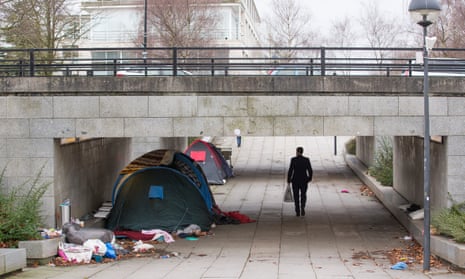At least 320,000 people are homeless in Britain, according to research by the housing charity Shelter.
This amounts to a year-on-year increase of 13,000, a 4% rise, despite government pledges to tackle the crisis. The estimate suggests that nationally one in 200 people are homeless.
Shelter says its figures, which include rough sleepers and people in temporary accommodation, are likely to be an underestimate of the problem as they do not capture people who experience “hidden” homelessness, such as sofa-surfers, and others living insecurely in sheds or cars, for example.
Newham in east London is ranked as England’s number one homelessness hotspot, with at least one in every 24 people in housing insecurity. More than 14,500 people were in temporary accommodation in the borough, and 76 were sleeping rough.
In the capital as a whole, 170,000 people – equivalent to one in 52 – have no home. Westminster had the most rough sleepers, 217, followed by Camden, with 127. In Kensington and Chelsea, the UK’s richest borough, there were over 5,000 homeless people – equivalent to one in every 29 residents.
The figures indicate how homelessness and housing insecurity is spreading beyond its traditional heartland of London into the wider south-east and Midlands, and the impact of high rents and welfare cuts ripples outwards.
Outside the capital, high homelessness rates were recorded in Birmingham, Luton, Brighton & Hove, Slough, Dartford, Milton Keynes, Harlow, Watford, Epsom, Reading, Broxbourne, Basildon, Peterborough and Coventry.
Regionally, homelessness grew fastest in the West Midlands and Yorkshire and Humberside, which saw 12% increases, followed by the north-west with an 11% rise. Homelessness fell in the north-east and south-west regions of England by 8%.
The 320,000 figure for England, Wales and Scotland was reached by combining government homelessness and rough-sleeping statistics at July 2018 with data on homeless hostel bed spaces and social services provision of temporary accommodation for families in crisis.
The bulk of those affected, 295,000, are in forms of temporary accommodation after being accepted as homeless by their local authority.
It is Shelter’s third annual analysis of homelessness. In 2016, it estimated there were 255,000 homeless people in England alone, a figure it subsequently adjusted to 294,000 for Britain. This rose to 307,000 in 2017.
Polly Neate, Shelter’s chief executive, said: “Due to the perfect storm of spiralling rents, welfare cuts and a total lack of social housing, record numbers of people are sleeping out on the streets or stuck in the cramped confines of a hostel room. We desperately need action now to change tomorrow for the hundreds of thousands whose lives will be blighted by homelessness this winter.”
The housing and communities secretary, James Brokenshire, said the government was determined to end homelessness but conceded more could be done. “No one should be left without a roof over their head, which is why we are determined to end rough sleeping and respond to the causes of homelessness.”
He added: “Our rough-sleeping strategy, support for councils and those working on the frontline are helping to get people off the street and into accommodation as we enter the colder winter months. But we know that there is more that we need to do and we’re committed to working with Shelter and others to make a positive difference.”
The government’s Homelessness Reduction Act came into force in May with the aim of forcing local authorities to take steps to prevent households at risk from falling into homelessness. It has also aims to eliminate rough sleeping by 2027.
Melanie Onn, the shadow housing minister, said: “It is appalling that enough people to fill a city the size of Newcastle will wake up this Christmas without a home. This is the outcome of eight years of austerity that even the United Nations say was designed to hurt the poor.”
